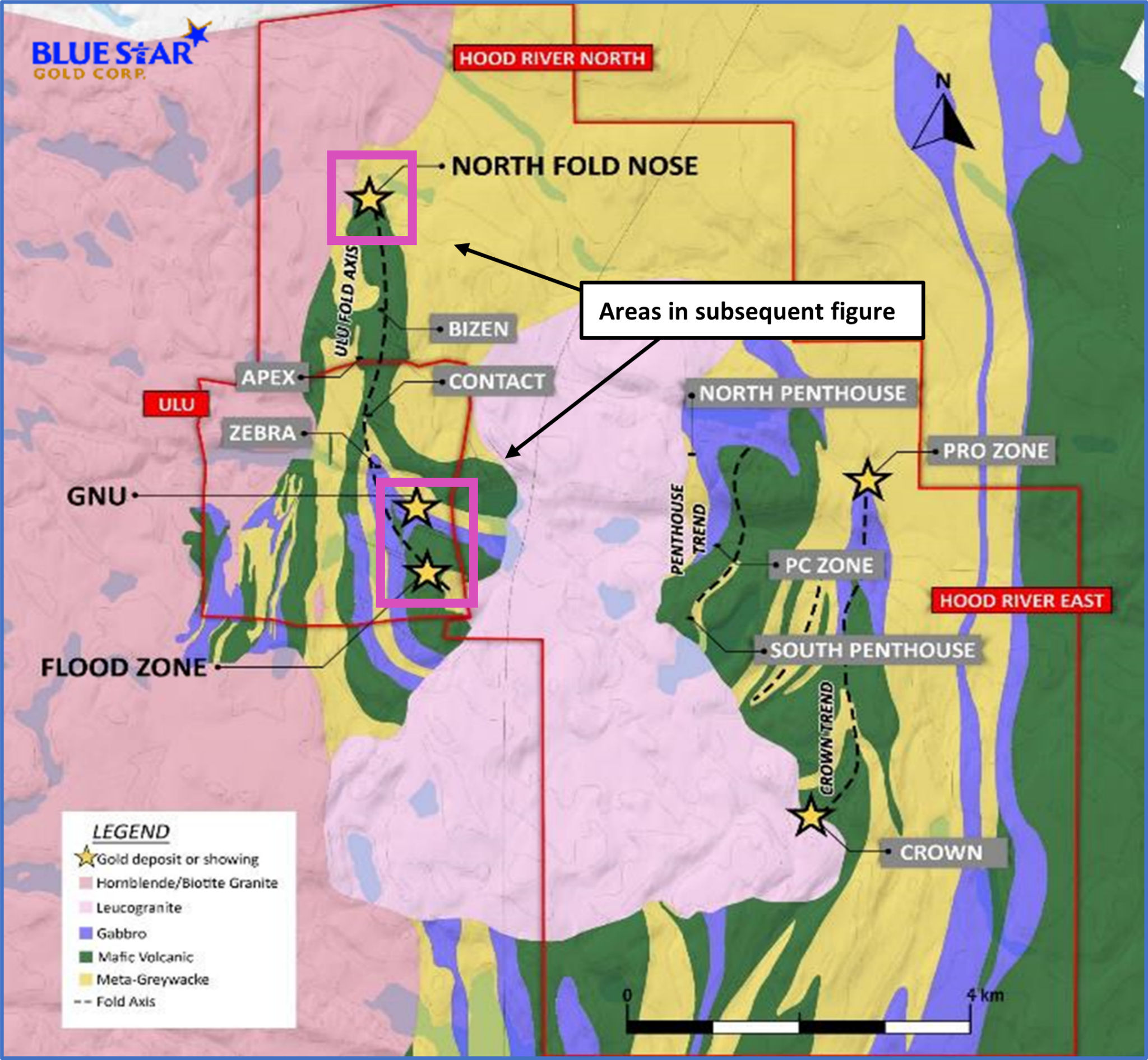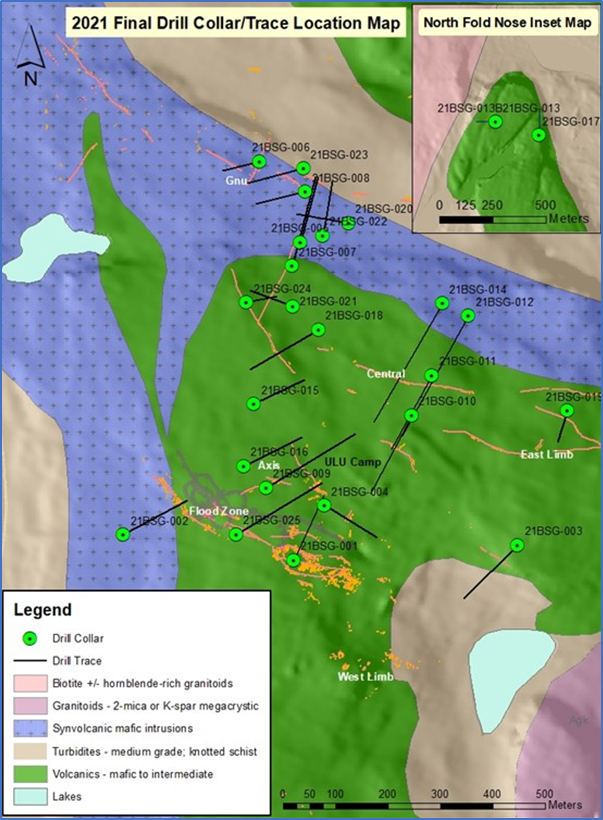Vancouver, British Columbia – October 20, 2021: Blue Star Gold Corp. (TSXV: BAU) (FSE: 5WP0) (“Blue Star” or the “Company”) provides an update on its 2021 exploration program at the Ulu and Hood River Projects located in the High Lake Greenstone Belt, Nunavut (Figure 1).
Highlights from the program
- Twenty-five drill holes completed for 5,012m of diamond core drilling evaluated 11 targets in six target zones; 2,534 core samples were collected for analysis (Table 1).
- Excellent results delivered from first two holes of the program (announced previously); and rushed results from a new vein system:
- New vein system discovered (see news release dated September 1, 2021) that returned 8.15m of 20.8 g/t gold ~750 metres northeast of the Flood Zone deposit; two Flood Zone holes returned 4.91m of 19.1 g/t gold, 7.00m of 6.9 g/t gold, and 2.64m of 13.0 g/t gold (see news release dated September 22, 2021).
- Flood Zone style mineralization intersected in several proximal targets including down to the 300m vertical level at the Central Zone and up to 2.5m wide in the Axis Zone.
- The technical team has begun a detailed assessment and evaluation of the program results which will continue through to year end as the balance of the assays are received.
- Second consecutive successful exploration season with no COVID issues; 471 tests completed during the program.
- 2,495-line km of airborne magnetometry data was collected.
- Remediation effort relocated 5,134 (compacted) cubic metres of historical solid waste to the approved landfill to satisfy the Company’s Land Use Permit (Figure 4).
- Safely completed inspections by CIRNAC and the Kitikmeot Inuit Association.
- Blue Star’s CEO Grant Ewing commented, “We successfully tested several prospective target areas during the drilling component of the current program. The discovery of a new vein system ~750 metres northeast of the Flood Zone deposit was an early success, and based on visual observations of the drill core, we anticipate more favorable results as assays from the balance of the program are retuned over the coming weeks.”
Summary
Blue Star initiated its 2021 exploration campaign on June 8th, 2021 with a program of selective camp improvements, equipment evaluation and planning for remediation efforts and a substantial drill program. Heli-borne magnetometry kicked off the exploration program in late June and completed in early July covering key target areas on Ulu and Hood River and was expanded to cover the Roma Fold target. Drilling was initiated on July 16th and remediation activities (landfill) started on July 15th. A second drill was made available July 31st and continued drilling through September.
COVID testing totaling 471 tests were conducted over the season. This is the second exploration season where the workforce was COVID negative.
Exploration drilling comprised of two holes for 348m at the NFN (North Fold Nose), 7 holes for 1,184m at the Gnu Zone, 6 holes for 1,520m at the Central Zones, 5 holes for 991m at the Axis Zone, 2 holes for 295m at the East Limb Zone and 3 holes for 674m at the Flood Zone. Additional exploration work included reviewing select sections of historical drill core in the Flood Zone, select mapping for structural controls in the Flood, Gnu, Central, East Limb, and NFN zones with preliminary mapping efforts at the Crown-Pro Trend and the Roma Project. An orientation till sampling program along with prospecting and selective sampling occurred on the Roma Project and prospecting and channel sampling occurred on the Crown-Pro trend.
Discussion of the 2021 exploration program
Flood Zone: Three holes were drilled to evaluate geological complexity and grade distribution questions with two holes extended to evaluate an unmodeled zone and the Axis Zone at moderate depths. Two of the holes have been reported in a news release dated September 22, 2021 including intercepts of 4.91m of 19.1 g/t gold and 2.64m of 13.0 g/t gold. Additional assays are pending.
The Axis Zone is considered a high priority target area due to its immediate proximity to the Flood Zone and existing underground development. Drilling in this area stepped along the surface expressions of alteration and mineralization that are interpreted to propagate along the Ulu fold axis immediately east of the Flood Zone (Figure 3). Despite the proximity and similarity in mineralization style to the Flood Zone no drilling was undertaken in this area by any company since the initial 1990 drill holes. Four holes were drilled covering approximately 200m of strike and 150m of vertical depth. Silicified zones with Flood Zone style acicular arsenopyrite up to 2.50m wide were intersected. Assays are pending.
The Central Zones are three zones sub-parallel to the Flood Zone deposit occurring on the east side of the Ulu fold hinge that may extend to the southeast to converge with the East Limb Zone. Historical drilling in this area was shallow; a three-hole fence was used to test all three Central Zones. Silicified zones with Flood Zone style acicular arsenopyrite up to 2.0m wide were intersected down to a vertical depth of 300m. A fourth hole stepping out from the deepest test and a shallow test where the Central and Axis Zones are inferred to merge were also part of this drilling. Assays are pending.
The Gnu Zone was previously modelled as a single sheet of mineralization however compilation of the data indicated two styles of mineralization in at least two different orientations are present. Three drill holes were used to test acicular arsenopyrite mineralization and six holes were used to evaluate two separate polymetallic quartz vein targets. Both styles of mineralization were intersected and initial results from this area included 8.15m of 20.8 g/t gold (news release dated September 1, 2021) with additional assays pending. A number of untested targets remain in this area.
NFN Zone: A small program consisting of two drillholes (21BSG013, 21BSG017) at the NFN zone was used to define a full cross section across the folded stratigraphy. Both holes intercepted the targeted polymetallic vein. This section will be used along with historical drilling to better define the fold, and more importantly the plunge of the hinge line. All assays are pending.
East Limb: One drill hole (21BSG003) evaluated the dip of the basalt-sediment contact on the east side of the Ulu fold and one drill hole (21BSG019) was used to better define the dip of mapped mineralized zones. Arsenopyrite bearing zones were intersected in both holes. Assays are pending.
Initial field work was conducted to evaluate known targets and geological controls on potential mineralization at the Crown-Pro trend in the Hood River Area. This involved limited wide spaced mapping and prospecting traverses and detailed evaluation of an inferred axial planar shear zone associated with tight folding of geological units – a feature similar to that of the known high grade Flood Zone deposit. Next steps include the complete compilation of historical work leading to target generation along the Crown-Pro fold axis similar to that undertaken on the Ulu fold axis in 2021.
The recently acquired 100% owned Roma Project received limited detailed mapping and sampling at the drill ready to near drill ready Roma Main and Roma Fold targets. The Roma Fold was a focus for the heliborne magnetometry survey. Prospecting sample results are pending. Drift prospecting lines of tight spaced basal till samples were conducted on parts of the property that have received little to no historical work based on the data compilation. This work is expected to derive the next tier of targets for follow up on the Roma Property. Results will be released as they are received and reviewed.
Table 1: Diamond Drill Hole Summary.

Figure 1: Map of Blue Star Properties.

Figure 2: Map of the Ulu and Hood River Area.

Figure 3: Plan Map of 2021 Drilling.

Figure 4: Change in Waste Piles from July to September 2021.

2021 Exploration Program
The exploration campaign evaluated several high priority targets in the area of the known high-grade Flood Zone Deposit on the Ulu Project, and on high potential targets along the Ulu fold hinge. Numerous priority targets exist along the 5 km long Ulu Anticline which extends from the Flood Zone Deposit on to the contiguous Hood River Project up to the North Fold Nose Zone. Objectives of the 2021 program included better understanding the controls of higher-grade zones within the hosting structures, evaluating additional structures on and adjacent to the Ulu fold hinge, and expanding and infilling previously known but undertested mineralized zones.
Assay results from the balance of the program will be reported as they are received. Full collar tables and assay tables will be made available on the website in due course. Core samples are being cut by core saw with one half of the core retained and the other half sent for analysis. Samples are being prepared by ALS Yellowknife-Geochemistry and being analyzed at ALS Global, North Vancouver. Gold analysis is by fire assay using ALS code Au-AA26 and multielement analysis by code ME-MS61. Control samples include a crush duplicate every 20 samples; certified reference material is being inserted once every ten samples. Reported assay intervals use a minimum 2 g/t gold assay cut off with the inclusion of up to 3m of material below cut-off. True widths for all but the Flood Zone are not known due to lack of drilling and may range from 30% to 90% of drilled lengths.
Qualified Person
Darren Lindsay, P. Geo. and Vice President Exploration for Blue Star, is a Qualified Person under National Instrument 43-101 (“NI 43-101”) and has reviewed and approved the technical information contained in this news release.
About Blue Star Gold Corp.
Blue Star is a gold company focused on exploration and development within Nunavut, Canada. The Company owns the Ulu Gold Property lease, an advanced gold project, and the highly prospective Hood River Property that is contiguous to the Ulu mining lease. With the recent acquisition of the Roma Project, Blue Star now controls over 16,000 hectares of highly prospective and underexplored mineral properties in the High Lake Greenstone Belt, Nunavut. A significant high-grade gold resource exists at the Flood Zone deposit (Ulu lease), and numerous high-grade gold occurrences and priority targets occur throughout the Ulu, Hood River and Roma Projects.
Blue Star is listed on the TSX Venture Exchange under the symbol: BAU and on the Frankfurt Exchange under the symbol: 5WP0. For information on the Company and its projects, please visit our website: www.bluestargold.ca.
For further information, please contact:
Grant Ewing, P. Geo., CEO
Telephone: +1 778-379-1433
Email:
Neither the TSX Venture Exchange nor its Regulation Services Provider (as that term is defined in the Policies of the TSX-Venture Exchange) accepts responsibility for the adequacy or accuracy of this Release.
CAUTIONARY NOTE REGARDING FORWARD-LOOKING STATEMENTS AND INFORMATION
This press release contains “forward-looking statements” within the meaning of applicable securities laws. Forward-looking statements can be identified by words such as: “anticipate,” “intend,” “plan,” “goal,” “seek,” “believe,” “project,” “estimate,” “expect,” “strategy,” “future,” “likely,” “may,” “should,” “will” and similar references to future periods. Examples of forward-looking statements include, among others, statements we make regarding prospective income and revenues, anticipated levels of capital expenditures for fiscal year, expectations of the effect on our financial condition of claims, litigation, environmental costs, contingent liabilities and governmental and regulatory investigations and proceedings, and estimates of mineral resources and reserves on our properties.
Forward-looking statements are neither historical facts nor assurances of future performance. Instead, they are based only on our current beliefs, expectations and assumptions regarding the future of our business, future plans and strategies, projections, anticipated events and trends, the economy and other future conditions. Because forward-looking statements relate to the future, they are subject to inherent uncertainties, risks and changes in circumstances that are difficult to predict and many of which are outside of our control. Our actual results and financial condition may differ materially from those indicated in the forward-looking statements. Therefore, you should not rely on any of these forward-looking statements. Important factors that could cause our actual results and financial condition to differ materially from those indicated in the forward-looking statements include, among others, the following: economic and financial conditions, including volatility in interest and exchange rates, commodity and equity prices and the value of financial assets, strategic actions, including acquisitions and dispositions and our success in integrating acquired businesses into our operations, developments and changes in laws and regulations, including increased regulation of the mining industry through legislative action and revised rules and standards applied by the regulatory bodies in Nunavut, changes in the price of fuel and other key materials and disruptions in supply chains for these materials, closures or slowdowns and changes in labour costs and labour difficulties, including stoppages affecting either our operations or our suppliers’ abilities to deliver goods and services to us, as well as natural events such as severe weather, fires, floods and earthquakes or man-made or other disruptions of our equipment, and inaccuracies in estimates of mineral resources and/or reserves on our mineral properties.
